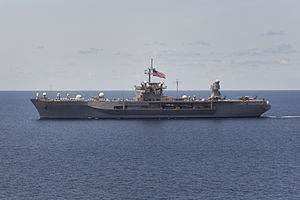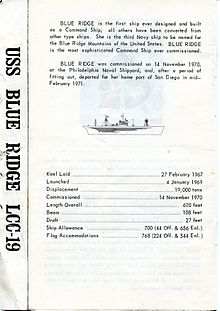 USS Blue Ridge (LCC-19) in 2012
| |
| History | |
|---|---|
| Name | Blue Ridge |
| Namesake | Blue Ridge Mountains |
| Ordered | 31 December 1964 |
| Builder | Philadelphia Naval Shipyard |
| Laid down | 27 February 1967 |
| Launched | 4 January 1969 |
| Sponsored by | Mrs. Gretchen Thompson-Byrd |
| Commissioned | 14 November 1970[1] |
| Homeport | Yokosuka, Japan |
| Identification | LCC-19 |
| Motto | Finest in the Fleet |
| Status | In active service |
| Badge |  |
| General characteristics | |
| Class and type | Blue Ridge-class command ship |
| Displacement | 19,609 tons |
| Length | 634 ft (193.2 m)[2] |
| Beam | 108 ft (32.9 m) |
| Draft | 28.9 ft (8.8 m) |
| Propulsion | 2 boilers, 1 geared turbine |
| Speed | 23 knots (43 km/h) |
| Range | 10,000 nmi (18,520 km) |
| Complement |
|
| Armament |
|
| Aircraft carried | 2 × Sikorsky SH-60 Seahawk helicopters |
| Aviation facilities | Flight deck |

USS Blue Ridge (LCC-19) is the lead ship of the two Blue Ridge-class amphibious command ships of the United States Navy, and is the flagship of the Seventh Fleet. Her primary role is to provide command, control, communications, computers, and intelligence (C4I) support to the commander and staff of the United States Seventh Fleet. She is currently forward-deployed to U.S. Navy Fleet Activities, Yokosuka in Japan, and is the third Navy ship named after the Blue Ridge Mountains, a range of mountains in the Appalachian Mountains of the eastern United States. Blue Ridge is the oldest deployed warship of the U.S. Navy, following the decommissioning of USS Denver.[3] Blue Ridge, as the U.S. Navy's active commissioned ship having the longest total period as active, flies the First Navy Jack instead of the jack of the United States.[4] Blue Ridge is expected to remain in service until 2039.[5][6][7]
- ^ "Blue Ridge". Naval Vessel Register.
- ^ "Amphibious Command Ships – LCC". U.S. Navy. Archived from the original on 12 March 2018. Retrieved 11 March 2018.
- ^ Peterson, LTJG Jonathan K. (13 August 2014). "USS Denver to Decommission after 46 Years of Service". U.S. Navy. Archived from the original on 14 August 2014. Retrieved 15 August 2014.
- ^ Sanders, MC3 Kelby (15 August 2014). "Blue Ridge Now 2nd Oldest Behind Constitution". USS Blue Ridge (LCC 19) Facebook page. U.S. Navy. Archived from the original on 8 October 2014. Retrieved 15 August 2014.
{{cite web}}: CS1 maint: numeric names: authors list (link) - ^ Ziezulewicz, Geoff (23 September 2011). "2 Navy ships getting new lease on life courtesy of budget concerns". Stars and Stripes. Archived from the original on 26 August 2014. Retrieved 8 June 2014.
- ^ "USS Blue Ridge Crew Completes Light-Off Assessment, Ignites Boilers". Amphibious Force 7th Fleet. 24 May 2018. Retrieved 2 March 2019.
- ^ "Policy Regarding Use of the U.S. Navy Flag, Battle Streamers, U.S. Navy Infantry Battalion Flag and the First Navy Jack". Bureau of Naval Personnel. 19 February 1990. Archived from the original on 26 February 2019.